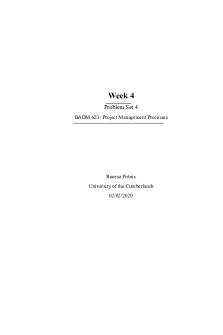week 4 Operational management PDF

| Title | week 4 Operational management |
|---|---|
| Author | Dzidzayi Godwins Munhungeyi |
| Course | Operations Management |
| Institution | University of the People |
| Pages | 2 |
| File Size | 49.6 KB |
| File Type | |
| Total Downloads | 115 |
| Total Views | 154 |
Summary
Operational Management week 4 Discussion assignment about challenges...
Description
Discussion 4 – Zara Apparel Retailer
Just as we learned in the past few weeks regarding inventories and supply chain, this week we dive further into global supply chain. According to this week’s discussion article, Zara’s Fashion Edge, this company has made a name for itself delivering “new clothes to stores quickly and in small batches… twice a week, at precise times… on schedule, new garments arrive” (Berfield & Baigorri, 2013). Sustaining growth in both local and global markets can be strategically and logically complex. The first discussion question asks about potential challenges Zara will face sustaining growth; in an article in the Ivey Business Journal, Bill Liabotis discusses the strategies for sustaining growth and he states that “most businesses fall short of achieving their growth objectives for revenue and profitability…. Because of two major reasons: inadequate consideration of opportunities within the core business, adjacent to the core business or within new customer sub-segments, (or) an organizational infrastructure that cannot support successful execution (Liabotis, 2017). Other potential challenges could be competition globally and locally, consumers can possibly purchase something cheaper as Zara doesn’t discount their products as often as other similar retailers do (Berfield & Baigorri, 2013).
The second question in the discussion is around the biggest challenge: I believe that the biggest challenge facing this company is growth, because with that growth, they have not changed anything about their distribution or supply chain. In 2013, China became the second largest country for Zara passing France with 142 stores. This poses a problem for a retail company who’s “secret to their success has been centralization” (Berfield & Baigorri, 2013). Could Zara continue without changing their ‘secret’ of centralization? They could, they could continue to expand with the exception of the Asian markets – this could potentially be an outsourcing opportunity, a way to increase production and reduce costs. Or they could continue on the same path with this expansion and try to decentralize production and distribution by region, or by each new market, but that would mean they would be changing ‘secret to their success’ and creating a new one! There are opportunities and new ways to look at things if one is open to them – as we know from experiences, work and otherwise, change isn’t easy personally or professionally.
In conclusion, supply chain is obviously a dynamic beast that can rear its ugly head with fluctuations of anything from inventory, capacity, production (or overproduction), to backlogs or unfulfilled orders, delays etc… (Berfield & Baigorri, 2013). But supply chains are only part of the puzzle of challenges facing companies. And growth sometimes spreads a company quite thin - but it doesn't have to. Zara's potential growth does not have to have anything to do with brick and mortar. This might prove more cost effective, but they would have to advertise more, and increase their networking capabilities. Zara could expand internationally by e-commerce. This would mean that they would need to spend some capital on IT infrastructure, advertising, and marketing but I believe that might be another way to gain market share.
REFERENCES Berfield, S. & Baigorri, M. (2013). Zara's Fashion Edge. Retrieved from: https://bambooinnovator.com/2013/11/20/zaras-fast-fashion-edge/#more-33581
Liabotis, B. (2017, December 4). Three strategies for achieving and sustaining growth. Ivey Business Journal. Retrieved February 17, 2022, from https://iveybusinessjournal.com/publication/three-strategies-for-achieving-and-sustaininggrowth/ 543 words...
Similar Free PDFs

week 4 Operational management
- 2 Pages

Operational Management chapter 4
- 2 Pages

Operational Management
- 1 Pages

Operational management-Apple Inc
- 14 Pages

Lesson 4 Operational Budgeting
- 8 Pages

Earned Value Management Week 4
- 4 Pages

WEEK 4 - Management OF A Company
- 8 Pages

Week 4 - week 4 Prac
- 9 Pages

Week 4 - Week 4 notes
- 4 Pages

Operational Auditing
- 3 Pages
Popular Institutions
- Tinajero National High School - Annex
- Politeknik Caltex Riau
- Yokohama City University
- SGT University
- University of Al-Qadisiyah
- Divine Word College of Vigan
- Techniek College Rotterdam
- Universidade de Santiago
- Universiti Teknologi MARA Cawangan Johor Kampus Pasir Gudang
- Poltekkes Kemenkes Yogyakarta
- Baguio City National High School
- Colegio san marcos
- preparatoria uno
- Centro de Bachillerato Tecnológico Industrial y de Servicios No. 107
- Dalian Maritime University
- Quang Trung Secondary School
- Colegio Tecnológico en Informática
- Corporación Regional de Educación Superior
- Grupo CEDVA
- Dar Al Uloom University
- Centro de Estudios Preuniversitarios de la Universidad Nacional de Ingeniería
- 上智大学
- Aakash International School, Nuna Majara
- San Felipe Neri Catholic School
- Kang Chiao International School - New Taipei City
- Misamis Occidental National High School
- Institución Educativa Escuela Normal Juan Ladrilleros
- Kolehiyo ng Pantukan
- Batanes State College
- Instituto Continental
- Sekolah Menengah Kejuruan Kesehatan Kaltara (Tarakan)
- Colegio de La Inmaculada Concepcion - Cebu





